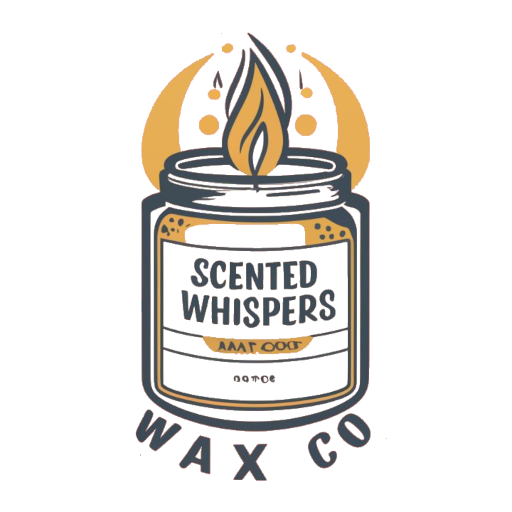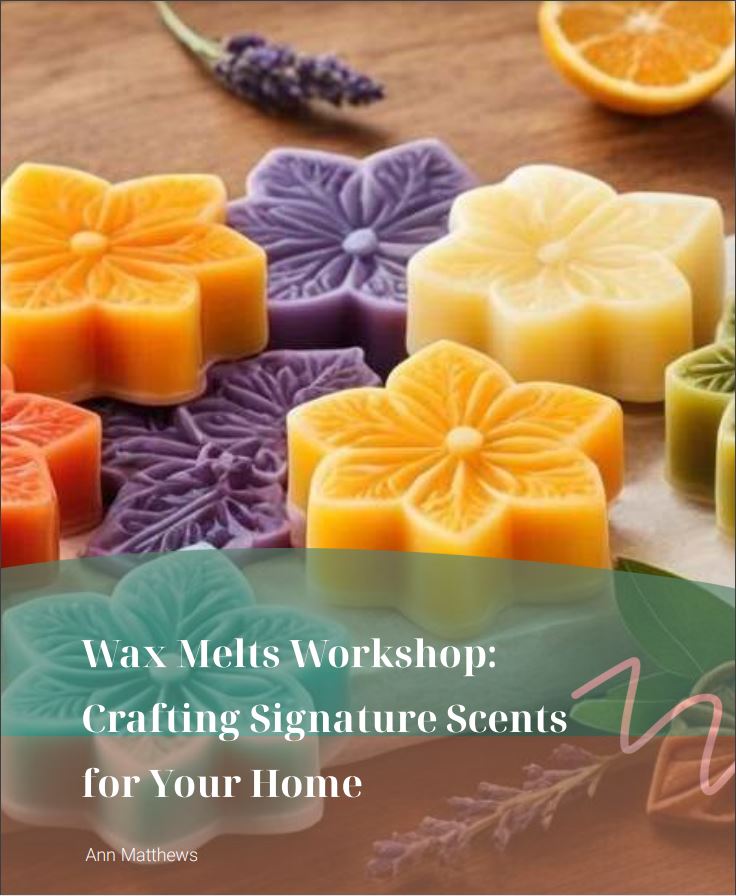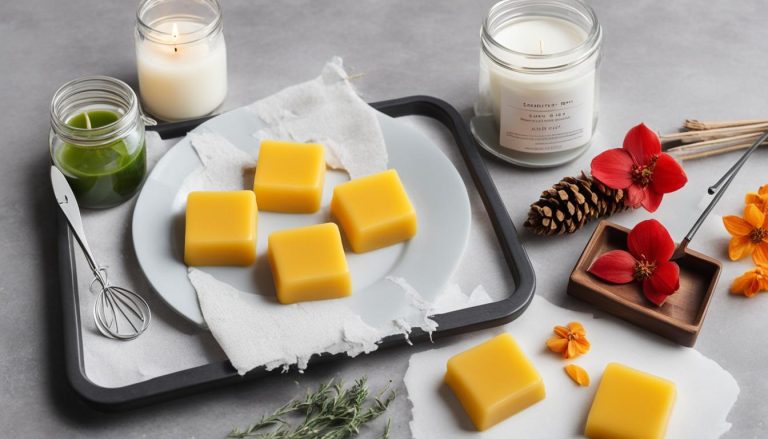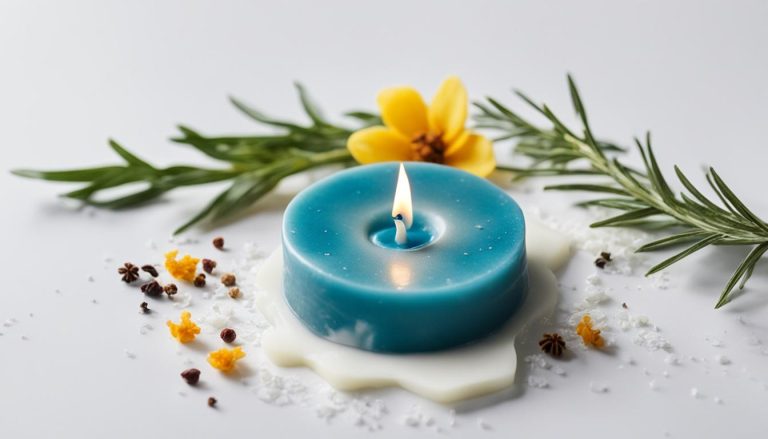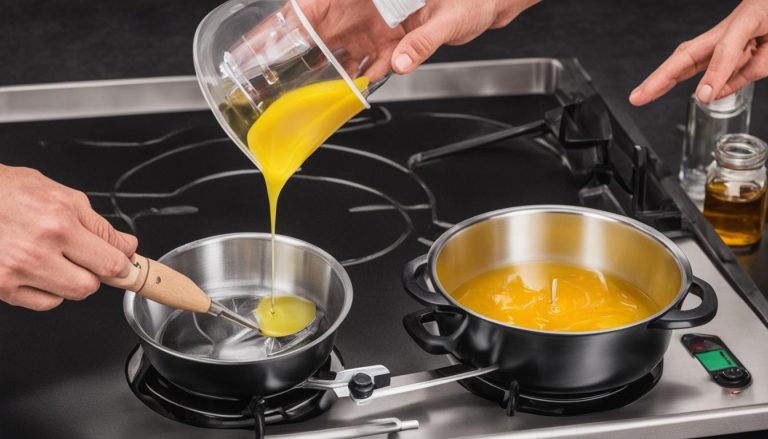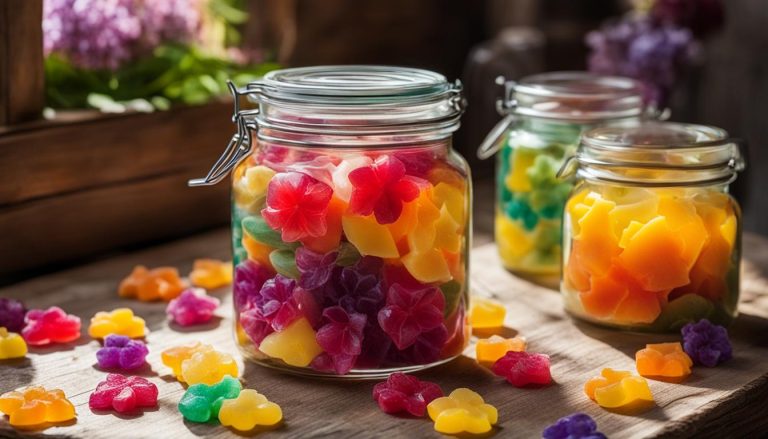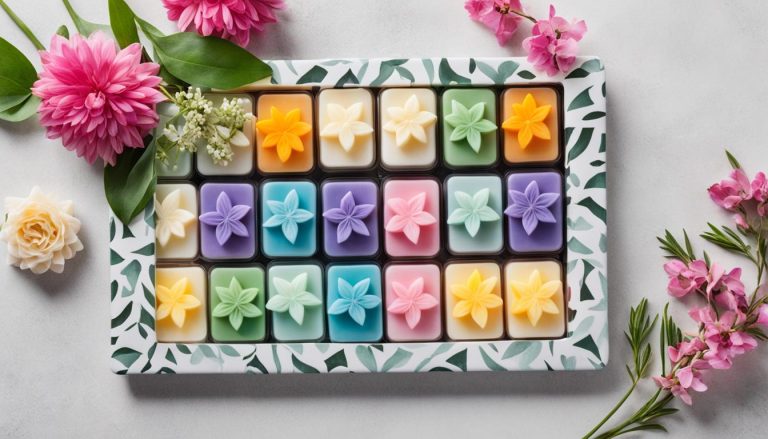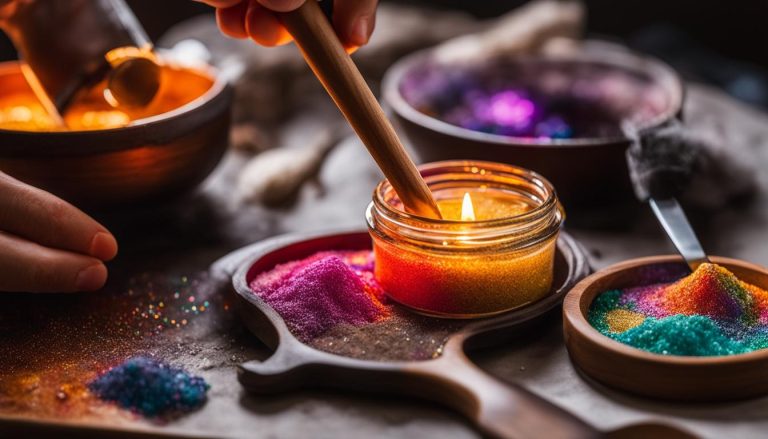Optimal Soy Wax Melting Temp for Candle Making
waxmelts.info and its partners may earn a commission if you purchase a product through one of our links
When it comes to creating beautiful and fragrant soy wax candles, achieving the optimal melting temperature is crucial. The right temperature ensures a smooth and even melt, resulting in high-quality candles with excellent fragrance throw and burning characteristics.
To melt soy wax for candle making, it is recommended to maintain a temperature range between 170°F and 180°F (77°C and 82°C). Using a thermometer to monitor the temperature is essential to prevent overheating and ensure consistent results. While some sources may suggest different temperature ranges, it’s best to follow the guidelines provided by your specific soy wax manufacturer or supplier.
Key Takeaways:
- Melt soy wax between 170°F and 180°F (77°C and 82°C) for optimal results.
- Use a thermometer to monitor the temperature and prevent overheating.
- Follow the guidelines provided by your soy wax manufacturer or supplier.
- The right melting temperature is important for achieving high-quality candles with optimal fragrance throw and burning characteristics.
- Achieving the correct temperature promotes even melting and consistency in your candle-making process.
Why Choose Soy Wax for Candles
Soy wax is a popular choice for candle making due to its numerous benefits. Made from renewable soybeans, soy wax provides a sustainable and eco-friendly option for candle enthusiasts. Unlike paraffin wax, soy wax burns clean and produces 90% less soot, ensuring a healthier and safer environment.
One of the key advantages of soy wax is its sustainable footprint. Soybeans are a renewable resource, making soy wax a more environmentally conscious choice. By opting for soy wax candles, you are actively supporting sustainable practices and reducing your carbon footprint.
Soy wax also offers a superior burning experience. It burns more evenly and cleanly, leaving no black soot residue on your walls or upholstery. This not only improves the longevity of your candles but also enhances the aesthetics of your living space.
In addition to its clean burning properties, soy wax is known for its excellent fragrance performance. It holds fragrances well, ensuring that your candles emit a strong and long-lasting scent. Whether you prefer subtle or bold fragrances, soy wax can deliver a satisfying olfactory experience.
Using soy wax means you can enjoy beautifully scented candles without compromising the air quality in your home.
Soy wax is also beginner-friendly and cost-effective. It is easy to work with, melts at a lower temperature compared to other waxes, and has a longer burning time. This makes it an ideal choice for those new to candle making or DIY enthusiasts looking for a rewarding and budget-friendly hobby.
When choosing soy wax for your candles, consider factors such as high fragrance load capability, good glass adhesion, and a strong cold and hot throw. Look for soy wax made from US-grown non-GMO soybeans to minimize environmental impact and support domestic farmers.
Benefits of Soy Wax for Candles:
- Renewable and sustainable: Made from renewable soybeans
- Clean burning: Produces 90% less soot than paraffin wax
- Environmentally friendly: Leaves a minimal carbon footprint
- Long-lasting and cost-effective: Provides a longer burning time
- Excellent fragrance performance: Holds fragrances well
| Benefits | Description |
|---|---|
| Clean Burning | Produces 90% less soot than paraffin wax |
| Sustainable Footprint | Made from renewable soybeans |
| Cost-Effective | Longer burning time and budget-friendly |
| Strong Fragrance Throw | Holds fragrances well for a pleasant scent experience |
Choosing Containers and Wicks for Soy Wax Candles
When it comes to making soy wax candles, selecting the right containers and wicks is essential for a successful outcome. The choice of containers and wicks directly affects the burn quality, fragrance distribution, and overall aesthetic appeal of your soy candles. Let’s explore the key considerations for choosing suitable containers and wicks.
Choosing Soy Candle Containers
For soy candles, it is important to opt for containers that can withstand the high temperatures generated by soy wax. Here are some container options that are ideal for soy candles:
- Glass Containers: Glass containers are a popular choice for soy candles due to their heat-resistant properties and elegant appearance.
- Ceramic Containers: Ceramic containers provide a unique and stylish look to your soy candles while offering excellent heat resistance.
- Metal Containers: Metal containers, such as tin or aluminum, are also suitable for soy candles as they can handle the heat without any issues.
Avoid using plastic containers for soy candles, as they are more prone to melting and can release harmful chemicals. Wood and raw clay containers are not recommended for soy candles as they tend to be too porous and may result in uneven burning.
Selecting Suitable Candle Wicks
The choice of wick plays a crucial role in achieving an even burn and proper fragrance distribution in your soy candle. Consider the following wick options for soy container candles:
- Wood Wicks: Wood wicks provide a unique crackling sound and aesthetic appeal, offering an enhanced sensory experience with their natural charm.
- Cotton Core Wicks: Cotton core wicks are widely used in soy candles for their clean and even burn. They provide a consistent flame and efficient fragrance release.
- Paper Core Wicks: Paper core wicks are another suitable option for soy container candles, offering good burn stability and precise fragrance diffusion.
Remember, it is crucial to use the recommended wick size for your specific soy wax and container to ensure optimal performance. This helps prevent issues such as tunneling, excessive smoke, or poor scent throw.
| Container Type | Wick Type | Best Features |
|---|---|---|
| Glass | Cotton Core Wicks | Even burn, good scent throw |
| Ceramic | Paper Core Wicks | Stable burn, precise fragrance diffusion |
| Metal | Wood Wicks | Natural crackling sound, unique aesthetic |
Choosing the right combination of soy candle containers and wicks ensures that your candles burn beautifully, provide a pleasant fragrance, and create a captivating ambiance in any space.
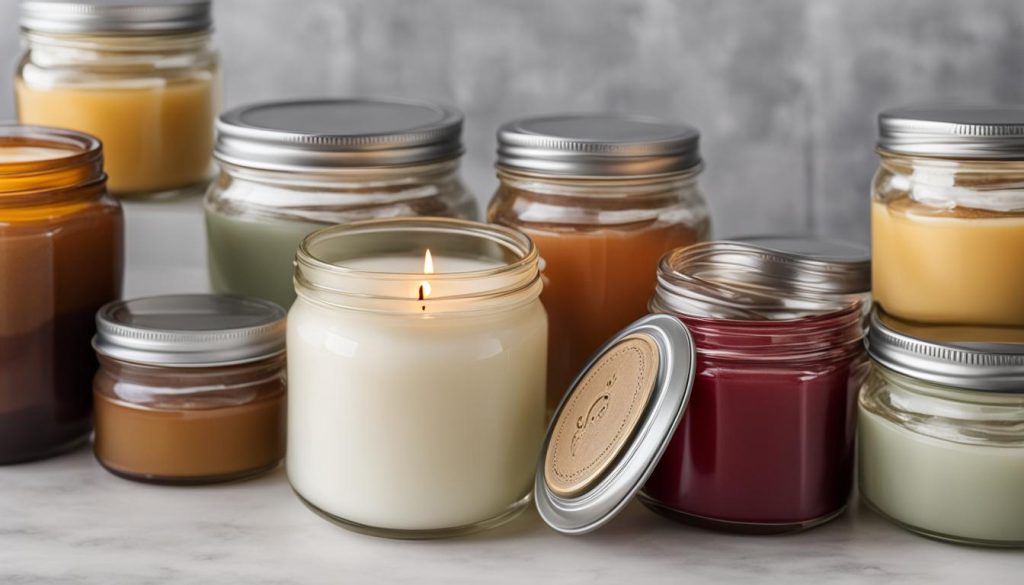
Melting and Adding Fragrance to Soy Wax
When it comes to melting soy wax for your candles, proper temperature control is key to achieving optimal results. Using a double boiler or a wax melter is recommended to regulate the heat and prevent overheating. Excessive heat can cause the wax to yellow, affecting the appearance of your candles.
The melting temperature for soy wax should not exceed 200°F (93°C). This ensures that the wax melts evenly and maintains its natural color. It’s important to use a thermometer to monitor the temperature throughout the melting process.
Once the soy wax has melted, it’s time to add fragrance oil to create beautifully scented candles. The recommended temperature range for adding fragrance oil to soy wax is typically between 175-185°F (79-85°C). This temperature allows the fragrance molecules to properly bond with the wax, ensuring a robust and long-lasting scent throw.
When adding fragrance oil, it’s essential to follow the recommended fragrance load. The fragrance load refers to the percentage of fragrance oil you should add to the total weight of the wax. Generally, a fragrance load of around 6% is recommended, but this can vary based on personal preference and the density of the fragrance oil.
Note: Remember to check the guidelines provided by your specific fragrance oil manufacturer for their recommended fragrance load and temperature range.
| Melting Soy Wax | Adding Fragrance Oil |
|---|---|
| Temperature Range: Up to 200°F (93°C) | Temperature Range: 175-185°F (79-85°C) |
| Prevent overheating and yellowing of the wax. | Ensure complete encapsulation of fragrance molecules. |
| Use a double boiler or wax melter for temperature control. | Follow recommended fragrance load based on total wax weight. |
Properly melting and adding fragrance to soy wax sets the foundation for creating beautifully scented candles. By maintaining the recommended temperature range and fragrance load, you can create candles that delight the senses and fill any space with wonderful aromas.
Pouring and Curing Soy Wax Candles
When it comes to pouring soy wax candles, the optimal pouring temperature can vary depending on the specific blend or brand of soy wax you are using. While the general industry standard suggests pouring the wax around 135°F (57°C) or when it starts to look slightly opaque, it’s important to note that some waxes may require higher pouring temperatures, ranging from 160-175°F (71-79°C). To achieve the best results, you should consider the overall temperature of your workspace and adjust the pouring temperature accordingly.
After pouring the candles, it’s important to allow them to cure for a minimum of 3-4 days, and ideally up to 2 weeks. This curing period allows the wax and fragrance molecules to fully bind together, resulting in an optimal hot throw when the candles are burned. Patience during the curing process is key to achieving the best possible fragrance performance.
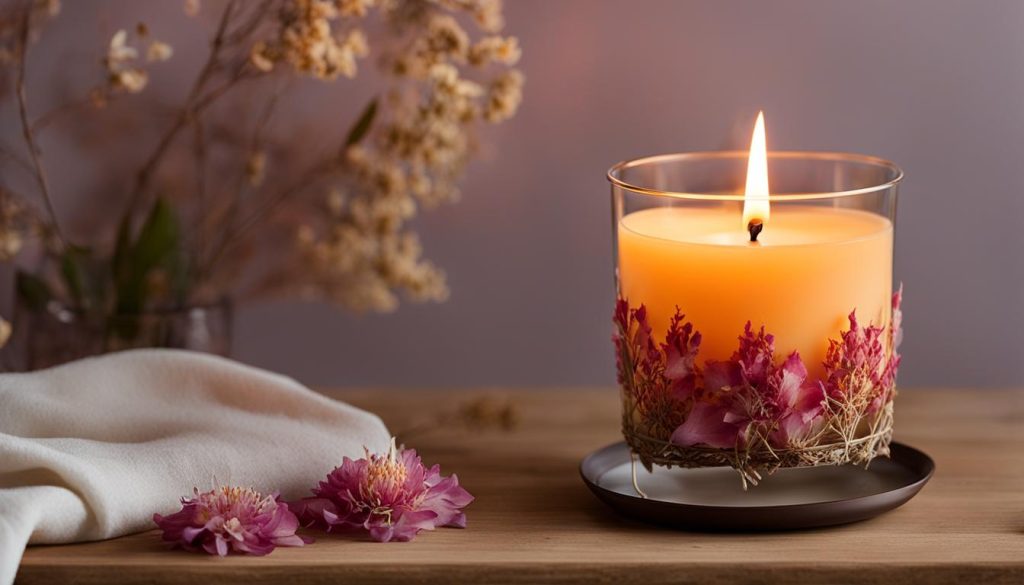
Importance of Curing
Curing candles is a crucial step in the candle-making process as it allows the fragrance to develop and settle within the wax. During the curing period, the soy wax undergoes a chemical process known as polymerization, where the fragrance molecules fuse with the wax molecules. This process enhances the scent throw of the candle when lit, ensuring a more robust and long-lasting fragrance experience.
While it can be tempting to burn your candles immediately after pouring, allowing them to cure will greatly improve their overall performance. The longer the curing time, the better the fragrance will develop, resulting in a more satisfying hot throw when the candles are burned.
Tips for Optimal Hot Throw
- Ensure the pouring temperature is appropriate for your specific soy wax.
- Choose high-quality fragrance oils with a suitable density and optimal hot throw performance.
- Follow the recommended fragrance load based on the total wax weight.
- Allow ample curing time for the wax and fragrance molecules to bind together.
By following these tips and allowing your soy wax candles to properly cure, you can achieve an optimal hot throw that fills your space with a delightful fragrance.
Troubleshooting Common Soy Wax Candle Issues
Although soy wax candles are known for their high-quality and clean-burning properties, they can sometimes encounter common issues that may affect their appearance. By understanding these issues and implementing some troubleshooting techniques, you can ensure that your soy wax candles turn out beautifully each time.
Frosting: One common issue is frosting, which appears as small snowflakes or crystallizing on the surface of the wax. This is purely aesthetic and does not affect the functionality of the candle. To minimize frosting, try using a lower pouring temperature or adding a small amount of stearic acid to your soy wax blend.
Delamination/Wet Spots: Delamination or wet spots occur when the wax pulls away from the container, leaving visible patches. This can happen due to temperature fluctuations during pouring and cooling. To prevent wet spots, ensure that the temperature remains consistent throughout the process. You can achieve this by preheating the container and pouring the wax slowly, while also keeping the room temperature stable.
Uneven Tops: Uneven tops or cratering can occur if the pouring temperature or room temperature is not optimal. To avoid this issue, make sure to follow the recommended pouring temperature for your specific brand or blend of soy wax. In addition, keep an eye on the room temperature, as extreme temperature changes can also cause uneven tops. Adjusting the pouring and cooling conditions will help you achieve a smooth and even finish.
FAQ
What is the ideal temperature to melt soy wax for candle making?
The ideal temperature to melt soy wax for candle making ranges between 170°F and 180°F (77°C and 82°C).
Why should I choose soy wax for candles?
Soy wax is made from renewable soybeans, making it a vegan and environmentally friendly option. It produces 90% less soot than paraffin wax, burns clean without emitting harmful chemicals, and holds fragrance well.
What kind of containers and wicks should I use for soy wax candles?
Glass, ceramic, and metal containers are ideal for soy candles. Avoid plastic, wood, and raw clay containers. For wicks, options like wood wicks, cotton core wicks, and paper core wicks work well for soy container candles.
How should I melt soy wax and add fragrance oil?
Use a double boiler or wax melter to melt soy wax at a temperature not exceeding 200°F (93°C). Add fragrance oil at a higher temperature, typically between 175-185°F (79-85°C), to ensure complete encapsulation of fragrance molecules.
What is the pouring and curing process for soy wax candles?
The pouring temperature for soy wax candles is typically around 135°F (57°C), but it can vary based on the specific blend or brand of soy wax. After pouring, allow the candles to cure for a minimum of 3-4 days and up to 2 weeks for optimal hot throw.
How can I troubleshoot common issues with soy wax candles?
Common issues with soy wax candles include frosting, delamination/wet spots, and uneven tops. These can be mitigated by adjusting the pouring temperature, using appropriate wax blends, and ensuring consistent temperature conditions during pouring and cooling.
